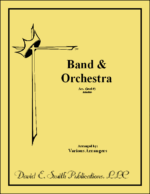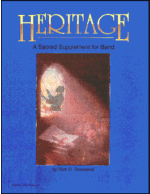-
-
I Have Decided To Follow Jesus
$37.00Intended for students with one or more years of playing experience, this arrangement features a very interesting but not difficult countermelody for low instruments, and will sound full even with a minimum of players. The main theme is featured twice, first in concert Bb with the melody in treble parts, and then in concert Eb with melody in lower instruments, along with a creative obbligato for upper instruments. The harmonies include an occasional chromatic treatment setting it apart from many traditional young band arrangements. Rhythm includes half, quarter and occasional eighth notes.
-
-
-
Faith Of Our Fathers
$35.00The selection opens with a declamatory fanfare. Following, the theme is presented in solo clarinet and later joined with a flute obligato. The lower wind parts present the theme with fanfare flourishes followed by woodwind counterlines. Block chords give a feeling of strength and conclusion and then ends with the fanfare that it began.
-
-
-
Children’s Hymn (Jesus Loves Me)
$35.00Children’s Hymn begins with all metallic percussion sounds (Sus. Cym., Trgl., & Bells) and flutes. Other sections of the band are gradually added until all instruments are playing. The melody is passed around to various instruments and the chorus is played tutti. The work ends the way it began with all metallic percussion and flutes.
-
-
-
Take Time To Be Holy
$32.00The piece begins in a subdued fashion (in F). The theme is then presented by upper woodwinds while supported by contrasting brass accompaniments. The middle section is an episode based on the texture of the opening theme. The form is an overall ABA with a reflective coda.
-
-
-
Nothing But the Blood
$32.00Beginning with a fanfare motif (in Eb) the theme alternates between dynamic shifts as though a question and answer. The lower instruments then augment the melody, followed by imitation in the upper voices. The ending mirrors the fanfare of the beginning.
-


